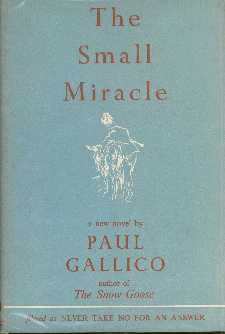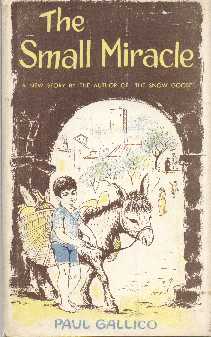 |  |
1951 - Michael Joseph | 1952 - Doubleday |
This story is set in Assisi, the home of St Francis. It is the story of Pepino, a poor orphan, and his donkey Violetta. When Violetta falls ill, and the vet cannot do anything for her, Pepino tries to get permission to take her into the crypt of St. Francis. But when that permission is denied, then he realises that he has to go to higher authority...
This is a remarkably short book, but it is quite quite lovely. I defy anyone not to get a lump in their throat when they read it for the first time.
Other information
This was filmed twice to my knowledge. The first was in 1951, as Never Take No for an Answer; the second was a Hallmark production in the early seventies.
The story first appeared in Good Housekeeping under the title Never Take No for an Answer.
Listen for Pleasure produced an audio book of this in 1979, along with The Snow Goose and Ludmila. It was read by Sir John Mills, and can still be found occasionally on eBay.
The US edition of the book has one of the more bizarre comments I have ever seen on the back flap:-
Published by DOUBLEDAY AND COMPANY, INC.
Publishers of the
Thorndike-Barnhart
Comprehensive Desk Dictionary
Availability
This book is available in Britain as a Penguin paperback, paired with The Snow Goose. If you have not read either, then buy this book - you have a treat in store. Second-hand copies of the hardback are not hard to find - firsts are not uncommon, either.
In 1953, a new edition was published in the UK, illustrated in colour by David Knight. This is rather difficult to find, but quite attractive if you do find it.
In 1973, a Hallmark book was published, called Paul Gallico's The Small Miracle. Be warned that this is merely an adaptation of the story by Edward Cunningham, based on the Hallmark TV film, and is truly naff. It's got some nice photos from the film, though.
The Small Miracle can also be found in a book of short stories called Angels and Awakenings, edited by M. Cameron Grey and published by Doubleday in the US in 1980. The stories in here are all about miracles and angels; it's actually considerably better than it sounds, and has some very fine stories by some very fine writers.
Paul Gallico - a biography
Paul William Gallico was born in New York City, on 26th July, 1897. His father was an Italian, and his mother came from Austria; they emigrated to New York in 1895.He went to school in the public schools of New York, and in 1916 went to Columbia University. He graduated in 1921 with a Bachelor of Science degree, having lost a year and a half due to World War I. He then worked for the National Board of Motion Picture Review, and after six months took a job as the motion picture critic for the New York Daily News. He was removed from this job as his "reviews were too Smart Alecky" (according to Confessions of a Story Teller), and took refuge in the sports department.
During his stint there, he was sent to cover the training camp of Jack Dempsey, and decided to ask Dempsey if he could spar with him, to get an idea of what it was like to be hit by the world heavyweight champion. The results were spectacular; Gallico was knocked out within two minutes. But he had his story, and from there his sports-writing career never looked back.
He became Sports Editor of the Daily News in 1923, and was given a daily sports column. He also invented and organised the Golden Gloves amateur boxing competition. During this part of his life, he was one of the most well-known sporting writers in America, and a minor celebrity. But he had always wanted to be a fiction writer, and was writing short stories and sports articles for magazines like Vanity Fair and the Saturday Evening Post. In 1936, he sold a short story to the movies for $5000, which gave him a stake. So he retired from sports writing, and went to live in Europe, to devote himself to writing. His first major book was Farewell to Sport, which as the title indicates, was his farewell to sports writing.
Though his name was well-known in the United States, he was an unknown in the rest of the world. In 1941, the Snow Goose changed all that, and he became, if not a best-selling author by today's standards, a writer who was always in demand. Apart from a short spell as a war correspondent between 1943 and 1946, he was a full-time freelance writer for the rest of his life. He has lived all over the place, including England, Mexico, Lichtenstein and Monaco, and he lived in Antibes for the last years of his life.
He was a first-class fencer, and a keen deep-sea fisherman. He was married four times, and had several children.
He died in Antibes on 15th July, 1976, just short of his 79th birthday.


No comments:
Post a Comment